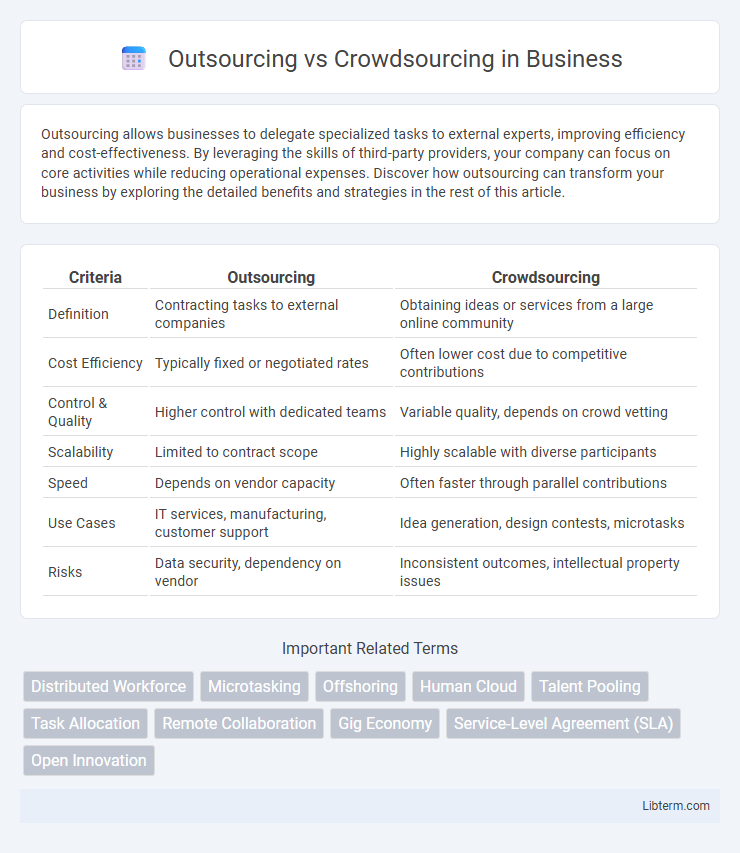Outsourcing allows businesses to delegate specialized tasks to external experts, improving efficiency and cost-effectiveness. By leveraging the skills of third-party providers, your company can focus on core activities while reducing operational expenses. Discover how outsourcing can transform your business by exploring the detailed benefits and strategies in the rest of this article.
Table of Comparison
| Criteria | Outsourcing | Crowdsourcing |
|---|---|---|
| Definition | Contracting tasks to external companies | Obtaining ideas or services from a large online community |
| Cost Efficiency | Typically fixed or negotiated rates | Often lower cost due to competitive contributions |
| Control & Quality | Higher control with dedicated teams | Variable quality, depends on crowd vetting |
| Scalability | Limited to contract scope | Highly scalable with diverse participants |
| Speed | Depends on vendor capacity | Often faster through parallel contributions |
| Use Cases | IT services, manufacturing, customer support | Idea generation, design contests, microtasks |
| Risks | Data security, dependency on vendor | Inconsistent outcomes, intellectual property issues |
Introduction to Outsourcing and Crowdsourcing
Outsourcing involves delegating specific business processes or tasks to external service providers to reduce costs and improve efficiency, typically relying on specialized companies or freelancers. Crowdsourcing taps into the collective intelligence of a large group of people, often through online platforms, to gather ideas, solve problems, or complete tasks at scale. Both strategies leverage external resources but differ in structure, control, and the nature of contributors.
Defining Outsourcing: Key Concepts
Outsourcing involves delegating specific business processes or tasks to external service providers, aiming to reduce costs, increase efficiency, and access specialized expertise. Key concepts include contract management, vendor selection, and maintaining quality control to ensure alignment with organizational goals. This strategic partnership often targets functions like IT services, customer support, and manufacturing to optimize resource allocation.
What is Crowdsourcing? An Overview
Crowdsourcing leverages the collective intelligence and skills of a large, diverse online community to complete tasks, solve problems, or generate ideas. It harnesses contributions from a broad audience, often through open calls, to improve innovation, reduce costs, and accelerate project timelines. Unlike traditional outsourcing that relies on specific vendors or contractors, crowdsourcing taps into a distributed workforce, enabling scalable and flexible resource allocation.
Differences Between Outsourcing and Crowdsourcing
Outsourcing involves delegating specific business tasks or processes to third-party companies, typically specializing in those functions, while crowdsourcing taps into a large, diverse online community to obtain ideas, services, or content on a task-by-task basis. The main difference lies in control and scale: outsourcing contracts a dedicated vendor with defined roles and deliverables, whereas crowdsourcing leverages multiple contributors often offering varied, innovative solutions. Cost structures also vary, with outsourcing usually requiring fixed pricing agreements, whereas crowdsourcing can involve lower costs by engaging many participants who compete or collaborate for rewards.
Benefits of Outsourcing for Businesses
Outsourcing enables businesses to reduce operational costs by leveraging specialized expertise and resources from external providers, leading to increased efficiency and focus on core activities. It facilitates access to advanced technology and skilled professionals without the need for long-term investments or recruitment challenges. Furthermore, outsourcing enhances scalability and flexibility, allowing companies to adjust quickly to market demands and streamline processes for improved overall performance.
Advantages of Crowdsourcing Solutions
Crowdsourcing solutions leverage a diverse, global pool of talent, enabling faster problem-solving and innovation through collective intelligence. This approach reduces operational costs by paying for contributions only when needed, making it highly scalable and flexible compared to traditional outsourcing. Access to varied skills and fresh perspectives drives creative, high-quality results that enhance competitive advantage.
Potential Drawbacks and Risks
Outsourcing risks include loss of control over quality and confidentiality issues due to handing tasks to external vendors, which may lead to communication barriers and delays. Crowdsourcing drawbacks involve inconsistent output quality, intellectual property concerns, and challenges in managing a dispersed, anonymous workforce. Both approaches require diligent vendor or participant vetting to mitigate risks related to reliability, security, and compliance.
Use Cases: When to Choose Outsourcing vs Crowdsourcing
Outsourcing is ideal for projects requiring specialized expertise, consistent quality, and long-term collaboration, such as software development, IT support, and manufacturing. Crowdsourcing suits tasks needing diverse input, rapid idea generation, or large-scale data collection, like innovation challenges, design contests, and content moderation. Choosing between outsourcing and crowdsourcing depends on the project's complexity, desired control level, and resource availability.
Best Practices for Successful Implementation
Establish clear objectives and define specific tasks or projects to ensure alignment with business goals when implementing outsourcing or crowdsourcing. Thoroughly vet potential partners or crowd contributors by evaluating their expertise, reliability, and quality of past work to maintain high standards. Implement robust communication channels and performance metrics to monitor progress, provide feedback, and facilitate timely adjustments for optimal results.
Future Trends in Outsourcing and Crowdsourcing
Future trends in outsourcing emphasize increased adoption of artificial intelligence and automation to enhance efficiency and reduce operational costs. Crowdsourcing is evolving with the integration of blockchain technology to ensure transparent contribution tracking and fair compensation. Both models are expected to leverage advanced data analytics and remote collaboration tools to optimize talent acquisition and project management globally.
Outsourcing Infographic

 libterm.com
libterm.com